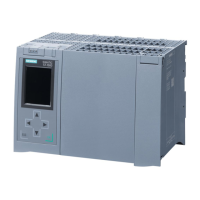System overview
5.3 S7-1500 R/H-CPUs
S7-1500R/H redundant system
System Manual, 01/2024, A5E41814787-AF
115
More information
You can find more information on the trace function in the Test functions (Page 471) section
and in the Using the trace and logic analyzer
(http://support.automation.siemens.com/WW/view/en/64897128) Function Manual.
5.3.7 PID control
PID controllers are built into all R/H-CPUs as standard. PID controllers measure the actual value
of a physical variable, for example, temperature or pressure, and compare the actual value
with the setpoint. Based on the resulting error signal, the controller calculates a manipulated
variable that causes the process value to reach the setpoint as quickly and stably as possible.
You can choose from three different PID technology objects:
The PID_Compact technology object provides a PID controller with integrated tuning for pro-
portional-action final controlling elements. Different operating modes are possible with
PID_Compact, e.g:
• Pretuning
• Fine tuning
• Automatic mode
• Manual mode
The PID_3Step technology object provides a PID controller with tuning for valves or actuators
with integrating behavior. You can configure the following controllers:
• Three-point stepping controller with position feedback
• Three-point stepping controller without position feedback
• Valve controller with analog output value
PID_Temp The PID_Temp technology object provides a continuous PID controller with integrated tuning.
PID_Temp is specially designed for temperature control and is suitable for heating or heat-
ing/cooling applications. Two outputs are available, one for heating and one for cooling. You
can also use PID_Temp for other control tasks. PID_Temp can be cascaded. You can use
PID_Temp in manual or automatic mode.
The display of the start value in the CPU and the corresponding comparison result in the
configuration editor of the PID technology object is only possible in the RUN
-Solo system

